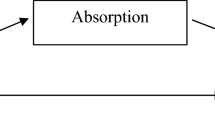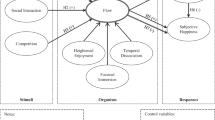Abstract
This paper offers an analytical description of the ethics of game design and its influence in the ethical challenges computer games present. The paper proposes a set of game design suggestions based on the Information Ethics concept of Levels of Abstraction which can be applied to formalise ethical challenges into gameplay mechanics; thus allowing game designers to incorporate ethics as part of the experience of their games. The goal of this paper is twofold: to address some of the reasons why computer games present ethical challenges, and to exploit the informational nature of games to suggest how to develop games with ethics at the core of their gameplay.
Similar content being viewed by others
References
Akrich, M., & Latour, B. (1992). A summary of a convenient vocabulary for the semiotics of human and nonhuman assemblies. In W. Bijker & J. Law (Eds.), Shaping technology, building society: Studies in sociotechnical change (pp. 259–264). Massachusetts: The MIT Press.
Arendt, H. (2006). Eichmann in Jerusalem. A report on the banality of evil. London: Penguin.
Bogost, I. (2007). Persuasive games. The expressive power of videogames. Massachusetts: The MIT Press.
Brey, P. (1999). The ethics of representation and action in virtual reality. Ethics and Information Technology, 1, 4–14.
Caillois, R. (2001). Man, play and games. Urbana and Chicago: University of Illinois Press.
Carnagey, N. L., Anderson, C. A., & Bushman, B. J. (2007). The effect of video game violence on physiological desensitization to real-life violence. Journal of Experimental Social Psychology, 43(3), 489–496.
Coeckelberg, M. (2007). Violent computer games, empathy, and cosmopolitanism. Ethics and Information Technology, 9, 219–231.
Conrad, J. (2004). Heart of darkness. Clayton: Prestwick House.
Floridi, L. (1999). Information ethics: On the theoretical foundations of computer ethics. Ethics and Information Technology, 1(1), 37–56.
Floridi., L. (2002). On the intrinsic value of information objects and the infosphere. Ethics and Information Technology, 4(4), 287–304.
Floridi, L. (2003). On the intrinsic value of information objects and the infosphere. Ethics and Information Technology, 4(4), 287–304.
Floridi, L. (2005). Information ethics: An environmental approach to the digital divide. Philosophy in the Contemporary World, 9(1), 39–45.
Floridi, L. (2008a). Information ethics: Its nature and scope. In J. van der Hoven & J. Weckert (Eds.), Moral philosophy and information technology (pp. 40–65). Cambridge: Cambridge University Press.
Floridi, L. (2008b). The method of levels of abstraction. Minds and Machines, 18(3), 303–329.
Floridi, L., & Sanders, J. W. (2001). Artificial evil and the foundation of computer ethics. Ethics and Information Technology, 3(1), 55–66.
Floridi, L., & Sanders, J. W. (2002). Computer ethics: Mapping the foundationalist debate. Ethics and Information Technology, 4(1), 1–9.
Floridi, L., & Sanders, J. W. (2005). Internet ethics. The constructionist values of Homo Poieticus. In R. J. Cavalier (Ed.), The impact of the internet in our moral lives (pp. 195–215). New York: SUNY.
Funk, J. B., Baldacci, H. B., Pasold, T., & Baumgardner, J. (2004). Violence exposure in real-life, video games, television, movies, and the internet: is there desensitization? Journal of Adolescence, 27, 23–29.
Funk, J. B., Buchman, D. D., Jenks, J., & Bechtold, H. (2003). Playing violent video games, desensitization, and moral evaluation in children. Journal of Applied Developmental Psychology, 24(4), 413–436.
Gadamer, H. G. (2004). Truth and method. New York: Continuum.
Hocking, C. (2007). Exploration—from systems to spaces to self. Talk at the Game Developers Conference, San Francisco, March 2007.
Huizinga, J. (1950). Homo ludens. Boston: Beacon Press.
Juul, J. (2005). Half-real. Video games between real rules and fictional worlds. Massachusetts: The MIT Press.
Juul, J. (2007). A certain level of abstraction, paper presented at the 3rd digital games researchers asociation conference, Tokyo, September 2007. Available online at http://www.jesperjuul.net/text/acertainlevel/. Accessed 27 Oct 2008.
Latour, B. (2002). Where are the missing masses? Sociology of a few mundane artefacts. In W. Bijker & J. Law (Eds.), Shaping technology, building society: Studies in sociotechnical change (pp. 225–258). Massachusetts: The MIT Press.
Murray, J. (1997). Hamlet on the holodeck. Massachusetts: The MIT Press.
Salen, K., & Zimmerman, E. (2004). Rules of play. Game design fundamentals. Massachusetts: The MIT Press.
Sicart, M. (2006). Game, player, ethics. Ph.D. Thesis, IT University of Copenhagen.
Smith, S. L., Lachlan, K., & Tamborini, R. (2003). Popular video games: Quantifying the presentation of violence and its context. Journal of Broadcasting and Electronic Media, 47(1), 58–76.
Wonderly, M. (2008). A humean approach to assessing the moral significance of ultra-violent video games. Ethics and Information Technology, 10, 1–10.
References: Games
Bioware (2003). Knights of the Old Republic.
Blizzard Entertainment (2005). World of Warcraft.
CCP (2003). Eve Online.
id Software (1993). Doom.
Introversion Software (2006). Defcon.
Ion Storm (2000). Deus Ex.
Konami (1998). Dance dance revolution.
Lionhead Studios (2004). Fable.
Newsgaming.com (2003). September 12th.
Pajitnov, A. (1985). Tetris.
Quantic Dream (2005). Fahrenheit.
Relentless (2006). Buzz! The Big Quiz.
RockStar North (2008). Grand Theft Auto IV.
RockStar North (2004). Manhunt.
Team Ico (2006). Shadow of the Colossus.
Valve (2000). Counter-Strike.
Author information
Authors and Affiliations
Corresponding author
Rights and permissions
About this article
Cite this article
Sicart, M. The banality of simulated evil: designing ethical gameplay. Ethics Inf Technol 11, 191–202 (2009). https://doi.org/10.1007/s10676-009-9199-5
Received:
Accepted:
Published:
Issue Date:
DOI: https://doi.org/10.1007/s10676-009-9199-5




